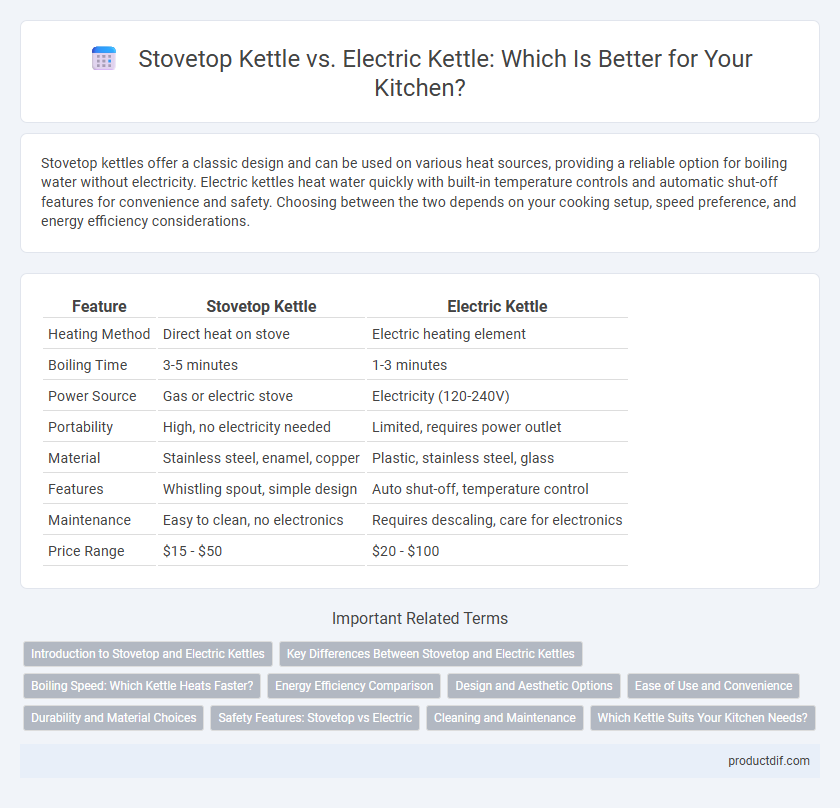Stovetop kettles offer a classic design and can be used on various heat sources, providing a reliable option for boiling water without electricity. Electric kettles heat water quickly with built-in temperature controls and automatic shut-off features for convenience and safety. Choosing between the two depends on your cooking setup, speed preference, and energy efficiency considerations.
Table of Comparison
| Feature | Stovetop Kettle | Electric Kettle |
|---|---|---|
| Heating Method | Direct heat on stove | Electric heating element |
| Boiling Time | 3-5 minutes | 1-3 minutes |
| Power Source | Gas or electric stove | Electricity (120-240V) |
| Portability | High, no electricity needed | Limited, requires power outlet |
| Material | Stainless steel, enamel, copper | Plastic, stainless steel, glass |
| Features | Whistling spout, simple design | Auto shut-off, temperature control |
| Maintenance | Easy to clean, no electronics | Requires descaling, care for electronics |
| Price Range | $15 - $50 | $20 - $100 |
Introduction to Stovetop and Electric Kettles
Stovetop kettles are traditional kitchenware items designed to heat water directly on a stove, made from materials like stainless steel or enamel, often featuring whistle mechanisms to signal boiling. Electric kettles use an internal heating element powered by electricity, offering rapid boiling times and automatic shut-off features for enhanced safety and convenience. Both types serve the essential function of boiling water, with stovetop kettles providing a classic aesthetic and electric kettles emphasizing speed and efficiency.
Key Differences Between Stovetop and Electric Kettles
Stovetop kettles require direct heat from a stove and typically offer a classic design with durable materials like stainless steel or enamel, while electric kettles use an internal heating element powered by electricity for faster boiling times and precise temperature control. Electric kettles often include features such as automatic shut-off and temperature settings, enhancing convenience and safety, whereas stovetop kettles rely on manual monitoring and produce a whistling sound when water reaches boiling point. Energy efficiency varies by model, but electric kettles generally consume less energy due to rapid heating and insulation technology compared to stovetop versions that may lose heat to the surrounding air.
Boiling Speed: Which Kettle Heats Faster?
Electric kettles typically boil water faster than stovetop kettles, reaching boiling point in about 3-5 minutes due to their built-in heating elements and efficient temperature control. Stovetop kettles rely on external heat sources like gas or electric burners, which can vary in power and often take 5-10 minutes to boil the same amount of water. Choosing an electric kettle can save time when rapid boiling is a priority in kitchenware performance.
Energy Efficiency Comparison
Stovetop kettles rely on direct heat from gas or electric burners, often resulting in longer boil times and higher energy consumption compared to electric kettles. Electric kettles feature rapid heating elements that can boil water more quickly and with greater energy efficiency, typically using 1200 to 1500 watts. Energy consumption studies show electric kettles use about 30% less energy on average per boil cycle, making them a more eco-friendly choice for daily use.
Design and Aesthetic Options
Stovetop kettles offer a classic, often vintage-inspired design with materials like stainless steel, copper, and enamel that complement traditional kitchens. Electric kettles provide sleek, modern aesthetics with minimalist lines and various color options, fitting contemporary and tech-savvy spaces. Both types showcase diverse styles, but stovetop kettles emphasize timeless charm while electric models highlight cutting-edge design and customization.
Ease of Use and Convenience
Stovetop kettles require manual heating on a gas or electric burner, offering simplicity but demanding constant supervision to avoid boiling over. Electric kettles feature automatic shut-off and rapid boiling technology, enhancing safety and speed for daily use. Their cordless design and temperature control options further improve convenience compared to traditional stovetop models.
Durability and Material Choices
Stovetop kettles, often crafted from stainless steel, cast iron, or enamel-coated metals, provide exceptional durability and can withstand high heat and frequent use without electrical components failing. Electric kettles usually feature a combination of plastic and stainless steel, which may be less robust over time but offer convenience with rapid boiling and automatic shutoff features. Choosing between the two hinges on prioritizing long-lasting material resilience versus modern functional efficiency in kitchenware.
Safety Features: Stovetop vs Electric
Stovetop kettles typically have simple safety features such as heat-resistant handles and whistle alerts indicating boiling water, but require careful supervision to avoid burns or fire hazards. Electric kettles offer advanced safety mechanisms including automatic shut-off when water reaches boiling point, boil-dry protection to prevent overheating, and cool-touch exteriors to reduce burn risks. These features make electric kettles generally safer for daily use, especially in busy kitchens or environments with children.
Cleaning and Maintenance
Stovetop kettles require regular descaling to prevent mineral buildup, often achieved by boiling vinegar or lemon juice inside the kettle, ensuring longevity and optimal performance. Electric kettles feature removable filters and usually have a sealed heating element, simplifying cleaning but demanding careful attention to avoid water damage during maintenance. Both types benefit from frequent emptying and drying after use to prevent mold and mildew growth.
Which Kettle Suits Your Kitchen Needs?
Stovetop kettles offer a classic option with durability and compatibility for various heat sources, ideal for those who appreciate traditional cooking methods and rustic kitchen aesthetics. Electric kettles provide speed and convenience with temperature control features, perfect for busy households or tea enthusiasts seeking precision and efficiency. Choosing between a stovetop kettle and an electric kettle depends on your kitchen's energy setup, desired brewing time, and personal lifestyle preferences.
Stovetop Kettle vs Electric Kettle Infographic

 productdif.com
productdif.com